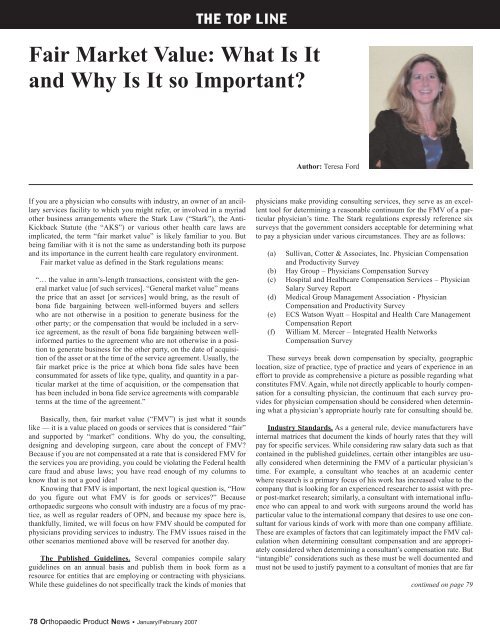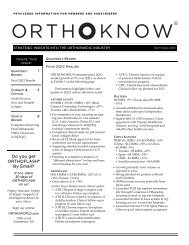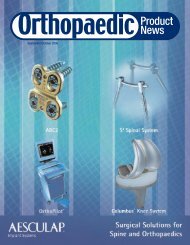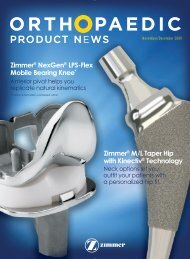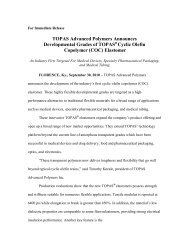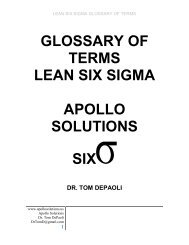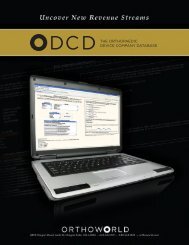AAOS, Arthroscopy - Orthoworld
AAOS, Arthroscopy - Orthoworld
AAOS, Arthroscopy - Orthoworld
Create successful ePaper yourself
Turn your PDF publications into a flip-book with our unique Google optimized e-Paper software.
THE TOP LINEFair Market Value: What Is Itand Why Is It so Important?Author: Teresa FordIf you are a physician who consults with industry, an owner of an ancillaryservices facility to which you might refer, or involved in a myriadother business arrangements where the Stark Law (“Stark”), the Anti-Kickback Statute (the “AKS”) or various other health care laws areimplicated, the term “fair market value” is likely familiar to you. Butbeing familiar with it is not the same as understanding both its purposeand its importance in the current health care regulatory environment.Fair market value as defined in the Stark regulations means:“… the value in arm’s-length transactions, consistent with the generalmarket value [of such services]. “General market value” meansthe price that an asset [or services] would bring, as the result ofbona fide bargaining between well-informed buyers and sellerswho are not otherwise in a position to generate business for theother party; or the compensation that would be included in a serviceagreement, as the result of bona fide bargaining between wellinformedparties to the agreement who are not otherwise in a positionto generate business for the other party, on the date of acquisitionof the asset or at the time of the service agreement. Usually, thefair market price is the price at which bona fide sales have beenconsummated for assets of like type, quality, and quantity in a particularmarket at the time of acquisition, or the compensation thathas been included in bona fide service agreements with comparableterms at the time of the agreement.”Basically, then, fair market value (“FMV”) is just what it soundslike — it is a value placed on goods or services that is considered “fair”and supported by “market” conditions. Why do you, the consulting,designing and developing surgeon, care about the concept of FMV?Because if you are not compensated at a rate that is considered FMV forthe services you are providing, you could be violating the Federal healthcare fraud and abuse laws; you have read enough of my columns toknow that is not a good idea!Knowing that FMV is important, the next logical question is, “Howdo you figure out what FMV is for goods or services?” Becauseorthopaedic surgeons who consult with industry are a focus of my practice,as well as regular readers of OPN, and because my space here is,thankfully, limited, we will focus on how FMV should be computed forphysicians providing services to industry. The FMV issues raised in theother scenarios mentioned above will be reserved for another day.The Published Guidelines. Several companies compile salaryguidelines on an annual basis and publish them in book form as aresource for entities that are employing or contracting with physicians.While these guidelines do not specifically track the kinds of monies thatphysicians make providing consulting services, they serve as an excellenttool for determining a reasonable continuum for the FMV of a particularphysician’s time. The Stark regulations expressly reference sixsurveys that the government considers acceptable for determining whatto pay a physician under various circumstances. They are as follows:(a)(b)(c)(d)(e)(f)Sullivan, Cotter & Associates, Inc. Physician Compensationand Productivity SurveyHay Group – Physicians Compensation SurveyHospital and Healthcare Compensation Services – PhysicianSalary Survey ReportMedical Group Management Association - PhysicianCompensation and Productivity SurveyECS Watson Wyatt – Hospital and Health Care ManagementCompensation ReportWilliam M. Mercer – Integrated Health NetworksCompensation SurveyThese surveys break down compensation by specialty, geographiclocation, size of practice, type of practice and years of experience in aneffort to provide as comprehensive a picture as possible regarding whatconstitutes FMV. Again, while not directly applicable to hourly compensationfor a consulting physician, the continuum that each survey providesfor physician compensation should be considered when determiningwhat a physician’s appropriate hourly rate for consulting should be.Industry Standards. As a general rule, device manufacturers haveinternal matrices that document the kinds of hourly rates that they willpay for specific services. While considering raw salary data such as thatcontained in the published guidelines, certain other intangibles are usuallyconsidered when determining the FMV of a particular physician’stime. For example, a consultant who teaches at an academic centerwhere research is a primary focus of his work has increased value to thecompany that is looking for an experienced researcher to assist with preorpost-market research; similarly, a consultant with international influencewho can appeal to and work with surgeons around the world hasparticular value to the international company that desires to use one consultantfor various kinds of work with more than one company affiliate.These are examples of factors that can legitimately impact the FMV calculationwhen determining consultant compensation and are appropriatelyconsidered when determining a consultant’s compensation rate. But“intangible” considerations such as these must be well documented andmust not be used to justify payment to a consultant of monies that are farcontinued on page 7978 Orthopaedic Product News • January/February 2007


